
The Eremin letter was a letter allegedly written by Colonel A. M Eryomin, a high-ranking member of the Okhrana, the secret police of the Russian Empire.

The Eremin letter was a letter allegedly written by Colonel A. M Eryomin, a high-ranking member of the Okhrana, the secret police of the Russian Empire.
The letter said that Joseph Stalin after being administratively exiled to the Turukhansky District, because of having been arrested in 1906, gave valuable intelligence information to the head of the Tiflis Provincial Directorate. In 1908, the head of the Baku Security Department received a number of information from Stalin, and then, upon Stalin’s arrival in St. Petersburg, Stalin became an agent of the St. Petersburg Security Department, and started providing information to the Tsar's police. [1] [2] It also said that when Stalin was elected to the Central committee of the Bolshevik party in 1910, he completely ceased to cooperate with the Okhrana. The claim that Stalin worked for the Okhrana has been made multiple times, but the Eremin letter is the only document that corroborates it. [1] The wider subject of his alleged collaboration with the Okhrana police still remains a debated issue among historians. [3]
In 1956, Soviet defector Alexander Orlov wrote an article for Life Magazine , "The Sensational Secret Behind the Damnation of Stalin", and according to him, the reason Stalin had purged Marshal Tukhachevsky and other members of the soviet military was because they discovered some documents which showed that Stalin had been a member of the Okhrana that infiltrated the Bolshevik movement. [4] The first appearance of the letter was in this article, which later appeared in various other works, such as in Stalin's Great Secret by Isaac Don Levine. The magazine also published Levine's article documenting the history of the appearance of the letter. [5]

Even among emigrants with anti-Soviet attitude, this “document” caused a sceptical reaction:
“And finally, one cannot ignore the noisy publication in the New York magazine Life (issue dated April 23) of a false document attempting to prove that Stalin was an agent of the Okhrana under tsarism. This pseudo-document was presented four years ago to B. Souvarine who immediately and categorically declared it a fake . "
A researcher at the State Archives of the Russian Federation (GARF) Zinaida Ivanovna Peregudova writes about the authenticity of Eremin’s “letter” :
The letter is dated July 12, 1913, but Colonel Eremin at that time was no longer the head of the Special Department of the Police Department, since on June 11, 1913 he was appointed head of the Finnish Gendarmerie Department. Consequently, he could not sign the letter as the head of the Special Department.
GARF has many documents signed by Eremin, which is very characteristic. A graphological examination clearly established that the signature under “Eremin’s letter” does not belong to Eremin.
The predominant view of historians in the west and in the countries of the former Soviet Union, is that the letter is most likely a forgery. [1] Stephen Kotkin, an acclaimed biographer of Stalin, said that it was normal for the Okhrana to cast doubts over genuine revolutionaries, by saying they were police agents. Both Leon Trotsky and Stalin came under suspicion of police collaboration. Those rumours always followed Stalin, but they were accusations his enemies failed to prove. [7] Kotkin remarked that in a certain occasion, one former Okhrana chief boasted, triumphant, that the revolutionaries started to suspect each other, so that in the end none of them could trust each other. [7]
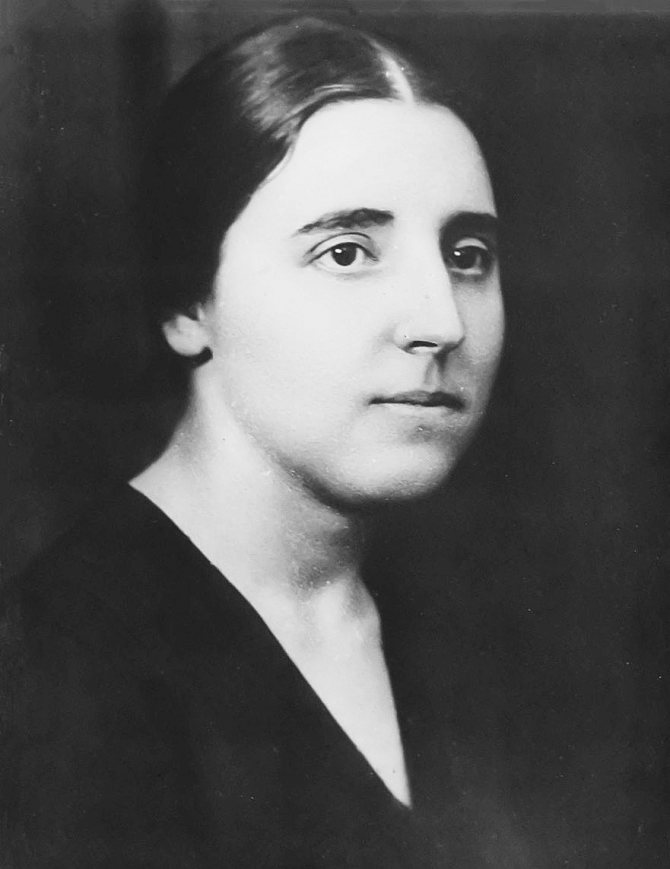
Nadezhda Sergeyevna Alliluyeva was the second wife of Joseph Stalin. She was born in Baku to a friend of Stalin, a fellow revolutionary, and was raised in Saint Petersburg. Having known Stalin from a young age, she married him when she was 17, and they had two children. Alliluyeva worked as a secretary for Bolshevik leaders, including Vladimir Lenin and Stalin, before enrolling at the Industrial Academy in Moscow to study synthetic fibres and become an engineer. She had health issues, which had an adverse impact on her relationship with Stalin. She also suspected he was unfaithful, which led to frequent arguments with him. On several occasions, Alliluyeva reportedly contemplated leaving Stalin, and after an argument, she fatally shot herself early in the morning of 7 November 1932.

Mikhail Ivanovich Kalinin was a Soviet politician and Russian Old Bolshevik revolutionary. He served as head of state of the Russian Soviet Federative Socialist Republic and later of the Soviet Union from 1919 to 1946. From 1926, he was a member of the Politburo of the Communist Party of the Soviet Union.

The Department for the Protection of Public Safety and Order, usually called the Guard Department and commonly abbreviated in modern English sources as the Okhrana was a secret police force of the Russian Empire and part of the police department of the Ministry of Internal Affairs (MVD) in the late 19th century and early 20th century, aided by the Special Corps of Gendarmes.
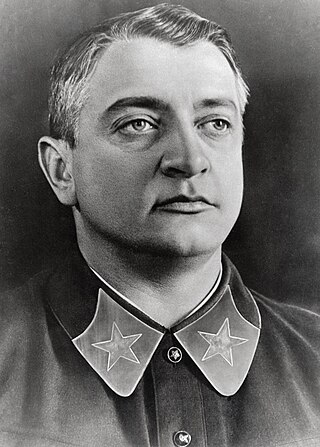
Mikhail Nikolayevich Tukhachevsky, nicknamed the Red Napoleon, was a Soviet general who was prominent between 1918 and 1937 as a military officer and theoretician. He was later executed during the Moscow trials of 1936–1938.

Genrikh Grigoryevich Yagoda was a Soviet secret police official who served as director of the NKVD, the Soviet Union's security and intelligence agency, from 1934 to 1936. Appointed by Joseph Stalin, Yagoda supervised arrests, show trials, and executions of the Old Bolsheviks Lev Kamenev and Grigory Zinoviev, climactic events of the Great Purge. Yagoda also supervised construction of the White Sea–Baltic Canal with Naftaly Frenkel, using penal labor from the gulag system, during which 12,000–25,000 laborers died.

Yakov Mikhailovich Sverdlov was a Russian revolutionary and Soviet politician who served as Chairman of the Secretariat of the Russian Communist Party (Bolsheviks) from 1918 until his death in 1919, and as Chairman of the All-Russian Central Executive Committee from 1917 until his death.
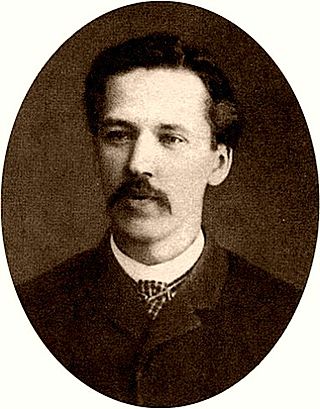
Sergei Vasilyevich Zubatov was a Russian Empire police administrator, best known as the advocate of "police socialism", which included creating legal, police-controlled trade unions.

Alexander Mikhailovich Orlov, was a colonel in the Soviet secret police and NKVD Rezident in the Second Spanish Republic. In 1938, Orlov refused to return to the Soviet Union due to fears of execution, and instead fled with his family to the United States. He is mostly known for secretly transporting the entire Spanish gold reserves to the USSR in exchange for military aid for Spanish Republic and for his book, The Secret History of Stalin's Crimes.

Ekaterine "Kato" Svanidze was the first wife of Joseph Stalin and the mother of his eldest son, Yakov Dzhugashvili.
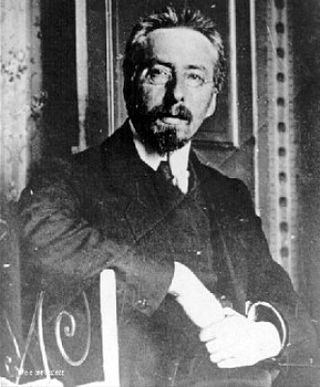
Vladimir Lvovich Burtsev was a revolutionary activist, scholar, publisher and editor of several Russian language periodicals. He became famous by exposing a great number of agents provocateurs, notably Yevno Azef in 1908. Because of his own revolutionary activities and his harsh criticism of the imperial regime, including personal criticism of emperor Nicholas II, he was imprisoned several times in various European countries. In the course of his life, Burtsev fought oppressive policies from Tsarism in Imperial Russia, followed by the Bolsheviks and later Adolf Hitler's National Socialism.
Pyotr Ivanovich Rachkovsky was chief of the Okhrana, the secret police in the Russian Empire. He was based in Paris from 1885 to 1902.
The Prague Conference, officially the 6th All-Russian Conference of the Russian Social Democratic Labour Party, was held in Prague, Austria-Hungary, on 5–17 January 1912. Sixteen Bolsheviks and two Mensheviks attended, although Joseph Stalin and Yakov Sverdlov were unable to attend because they were in internal exile at the time, while Georgi Plekhanov claimed he was too ill to attend. At the conference, Vladimir Lenin and his supporters broke away from the rest of the Russian Social Democratic Labour Party and formed their own predominantly Bolshevik Russian Social Democratic Labour Party. The conference was meant to be secret; Lenin had instructed: "No-one, no organisation must know about this". However, every detail was known to the Okhrana, the secret police of the Russian Empire.

Roman Vatslavovich Malinovsky was a prominent Bolshevik politician before the Russian revolution, while at the same time working as the best-paid agent for the Okhrana, the Tsarist secret police. They codenamed him 'Portnoi'.

Alexander Ivanovich Spiridovich was a police general in the Russian Imperial Guard. He became a historian after he had left Russia.

The early life of Joseph Stalin covers the period from Stalin's birth, on 18 December 1878, until the October Revolution on 7 November 1917. Born Ioseb Besarionis dze Jughashvili in Gori, Georgia, to a cobbler and a house cleaner, he grew up in the city and attended school there before moving to Tiflis to join the Tiflis Seminary. While a student at the seminary he embraced Marxism and became an avid follower of Vladimir Lenin, and left the seminary to become a revolutionary. After being marked by Russian secret police for his activities, he became a full-time revolutionary and was involved in a various criminal activities as a robber, gangster and arsonist. He became one of the Bolsheviks' chief operatives in the Caucasus, organizing paramilitaries, spreading propaganda, raising money through bank robberies, and kidnappings and extortion. Stalin was captured and exiled to Siberia numerous times, but often escaped. He became one of Lenin's closest associates, which helped him rise to the heights of power after the Russian Revolution. In 1913 Stalin was exiled to Siberia for the final time, and remained in exile until the February Revolution of 1917 led to the overthrow of the Russian Empire.

Nikolai Aleksandrovich Uglanov was a Russian Bolshevik politician and Soviet statesman who played an important role in the government of the Soviet Union as a Communist Party leader in the city of Moscow during the 1920s. Uglanov was closely associated with the so-called "Right Deviation" associated with Soviet party leader Nikolai Bukharin and he fell from his leadership position during the mass collectivization campaign of 1929. Uglanov was arrested in the summer of 1936 and was executed the following spring during the secret police terror of 1937–38.

Sergey Petrovich Degayev was a Russian revolutionary terrorist, Okhrana agent, and the murderer of inspector of secret police Georgy Sudeykin. After emigrating to the United States, Degayev took the name Alexander Pell and became a prominent American mathematician, the founder of school of Engineering at the University of South Dakota. The Dr. Alexander Pell scholarship is named in his honor.

The 1907 Tiflis bank robbery, also known as the Erivansky Square expropriation, was an armed robbery on 26 June 1907[a] in the city of Tiflis in the Tiflis Governorate in the Caucasus Viceroyalty of the Russian Empire. A Bolshevik group "expropriated" a bank cash shipment to fund their revolutionary activities. The robbers attacked a bank stagecoach, and the surrounding police and soldiers, using bombs and guns while the stagecoach was transporting money through Erivansky Square between the post office and the Tiflis branch of the State Bank of the Russian Empire. The attack killed forty people and injured fifty others, according to official archive documents. The robbers escaped with 241,000 rubles.
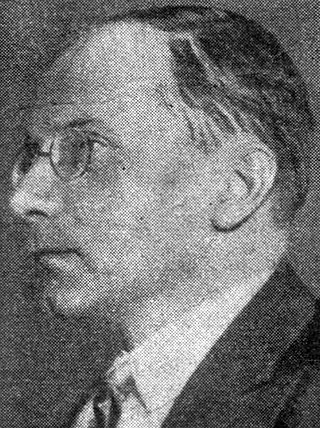
Aleksei Ivanovich Stetskii was a Russian Soviet politician, journalist and official and propagandist of the All-Union Communist Party (Bolsheviks).

Elena Fyodorovna Rozmirovich-Troyanovskaya was a Russian revolutionary and politician and later an official in the Soviet Union. In 1917 she was one of the ten women elected to the Constituent Assembly, becoming the country's first female parliamentarians.